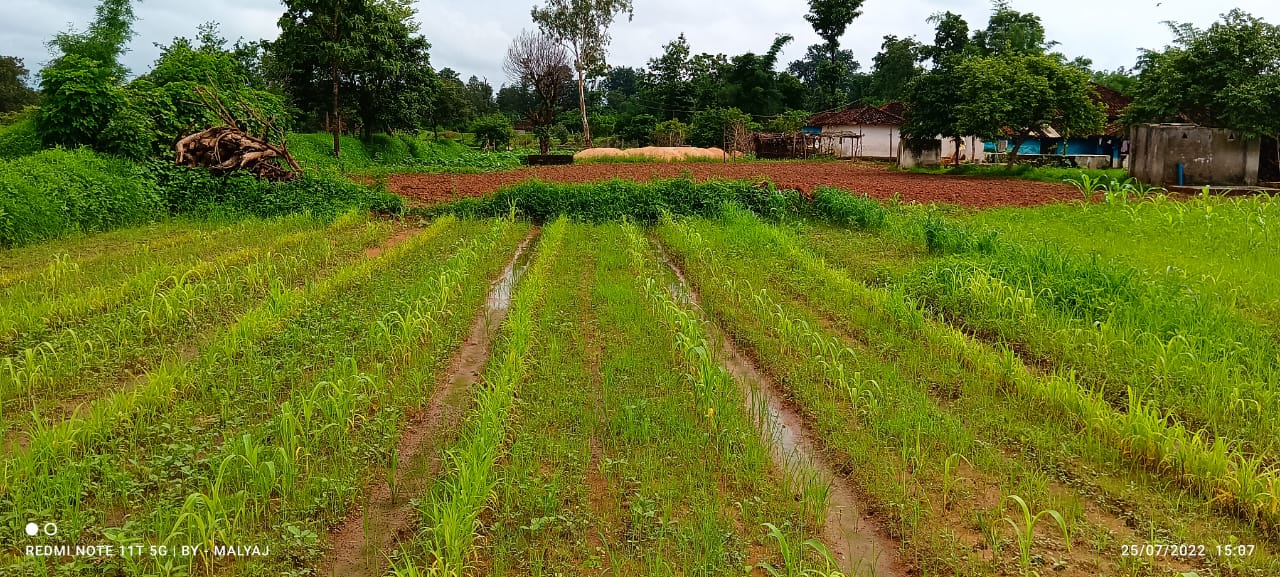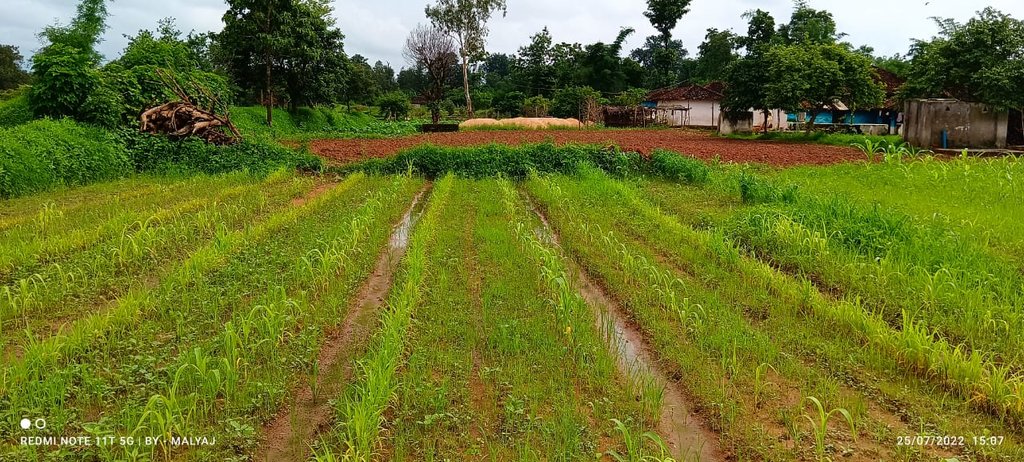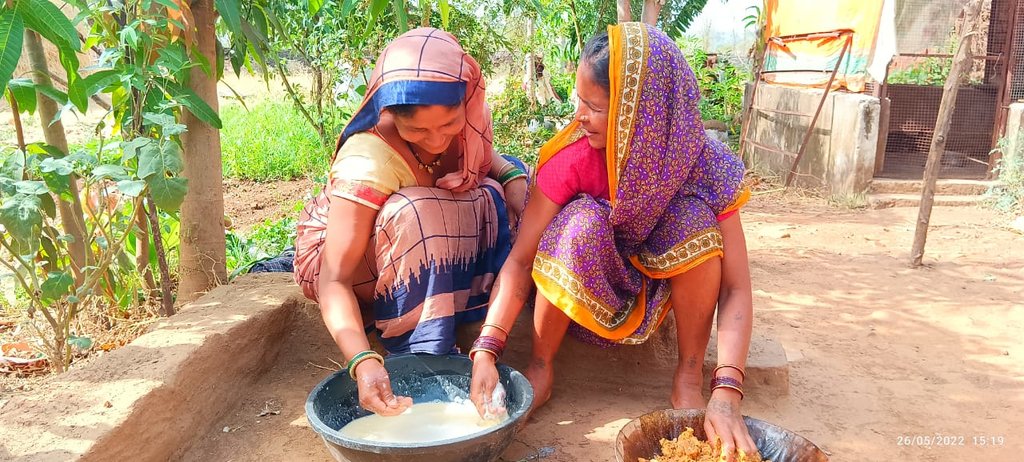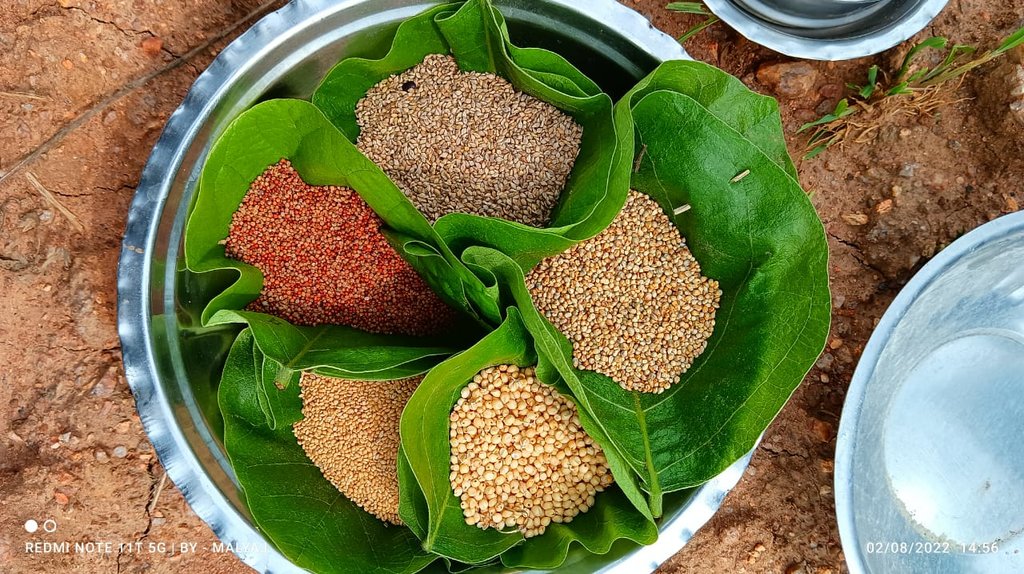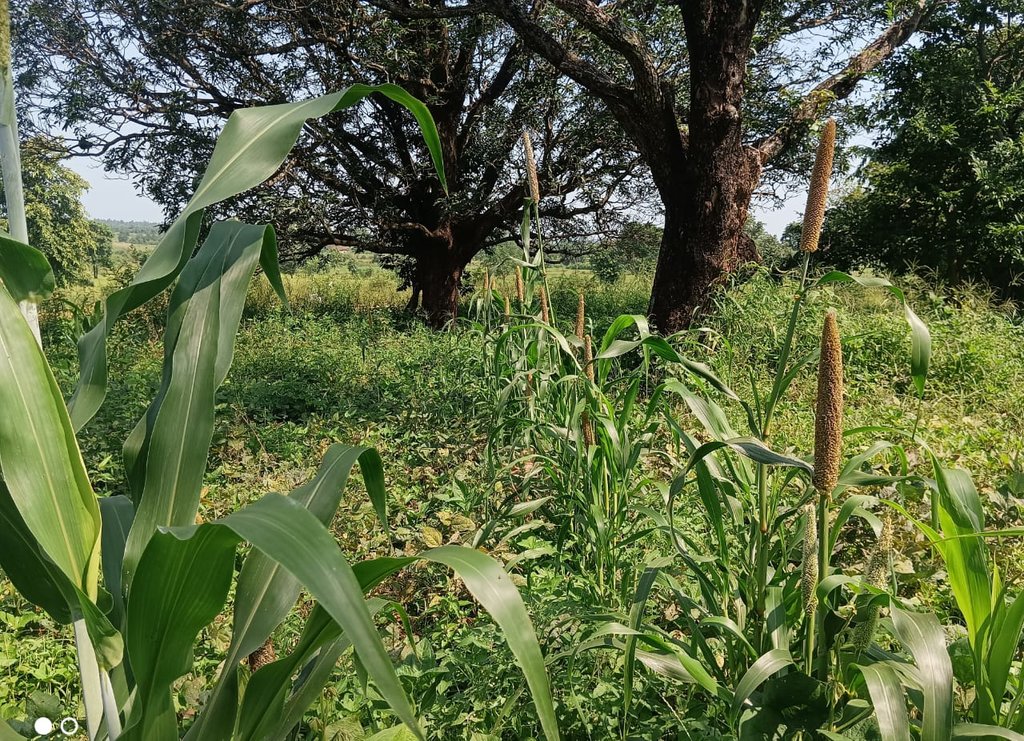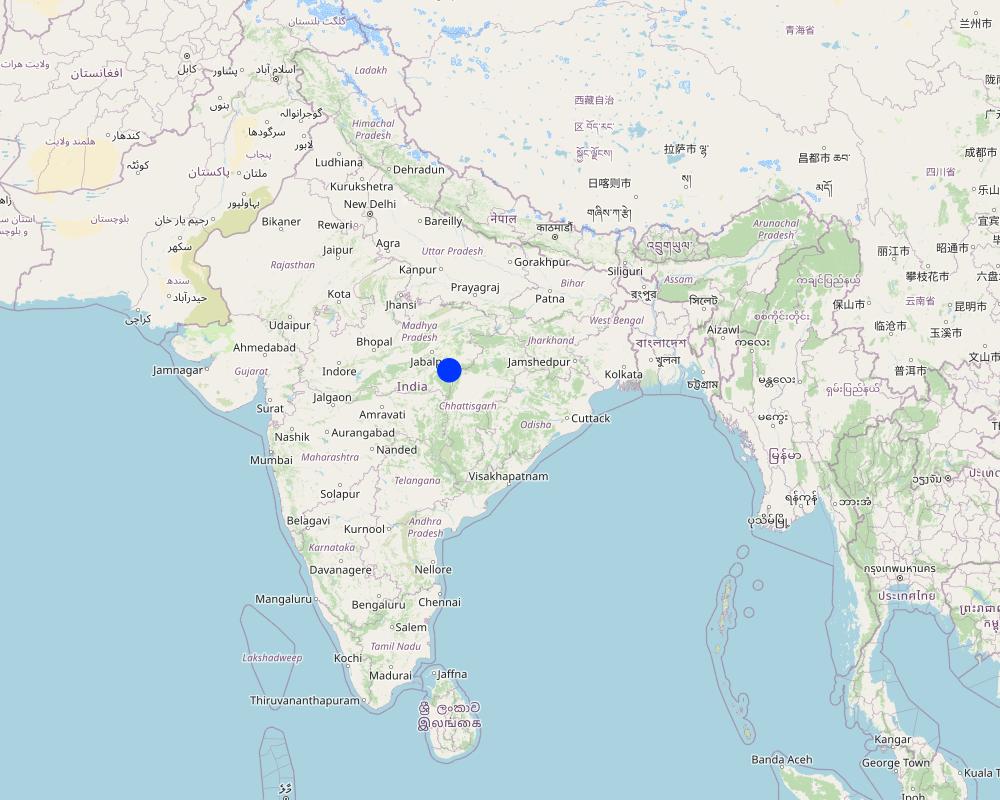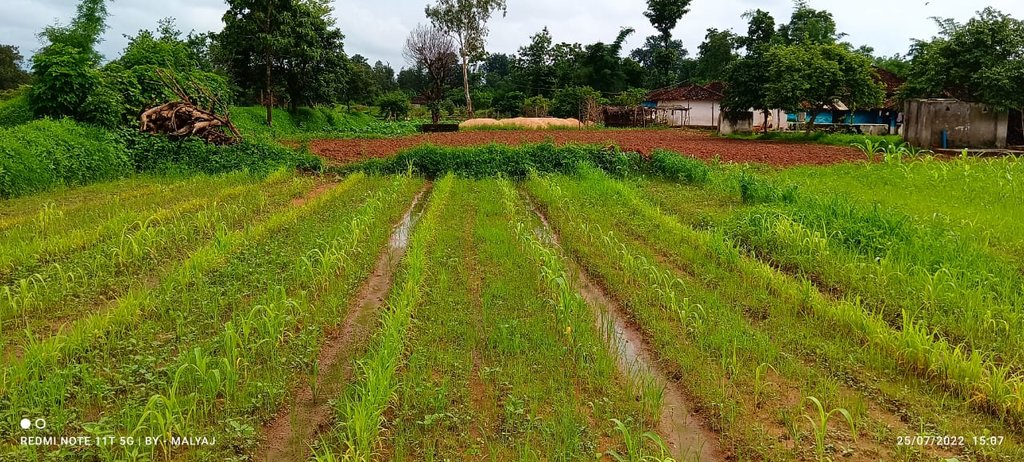Pre-Monsoon Dry Sowing (PMDS) [ប្រទេសឥណ្ឌា]
- ការបង្កើត៖
- បច្ចុប្បន្នភាព
- អ្នកចងក្រង៖ Santosh Gupta
- អ្នកកែសម្រួល៖ Noel Templer, Stephanie Katsir, Kim Arora, Tabitha Nekesa, Ahmadou Gaye, Siagbé Golli
- អ្នកត្រួតពិនិត្យច្រើនទៀត៖ Udo Höggel, Sally Bunning
technologies_6697 - ប្រទេសឥណ្ឌា
ពិនិត្យមើលគ្រប់ផ្នែក
ពង្រីកមើលទាំងអស់ បង្រួមទាំងអស់1. ព័ត៌មានទូទៅ
1.2 ព័ត៌មានលម្អិតពីបុគ្គលសំខាន់ៗ និងស្ថាប័នដែលចូលរួមក្នុងការវាយតម្លៃ និងចងក្រងឯកសារនៃបច្ចេកទេស
ឈ្មោះគម្រោងដែលបានចងក្រងឯកសារ/ វាយតម្លៃលើបច្ចេកទេស (បើទាក់ទង)
Soil protection and rehabilitation for food security (ProSo(i)l)ឈ្មោះអង្គភាពមួយ (ច្រើន) ដែលបានចងក្រងឯកសារ/ វាយតម្លៃបច្ចេកទេស (បើទាក់ទង)
Deutsche Gesellschaft für Internationale Zusammenarbeit - India (GIZ India) - ប្រទេសឥណ្ឌាឈ្មោះអង្គភាពមួយ (ច្រើន) ដែលបានចងក្រងឯកសារ/ វាយតម្លៃបច្ចេកទេស (បើទាក់ទង)
CIAT International Center for Tropical Agriculture (CIAT International Center for Tropical Agriculture) - ប្រទេសកេនយ៉ាឈ្មោះអង្គភាពមួយ (ច្រើន) ដែលបានចងក្រងឯកសារ/ វាយតម្លៃបច្ចេកទេស (បើទាក់ទង)
Ecociate Consultants (Ecociate Consultants) - ប្រទេសឥណ្ឌា1.3 លក្ខខណ្ឌទាក់ទងទៅនឹងការប្រើប្រាស់ទិន្នន័យដែលបានចងក្រងតាមរយៈ វ៉ូខេត
អ្នកចងក្រង និង(បុគ្គលសំខាន់ៗ)យល់ព្រមទទួលយកនូវលក្ខខណ្ឌនានាទាក់ទងទៅនឹងការប្រើប្រាស់ទិន្នន័យដែលបានចងក្រងតាមរយៈវ៉ូខេត:
បាទ/ចា៎
1.4 សេចក្តីប្រកាសស្តីពីចីរភាពនៃការពណ៌នាពីបច្ចេកទេស
តើបច្ចេកទេសដែលបានពណ៌នានេះមានបញ្ហាដែលផ្តោតលើការធ្លាក់ចុះគុណភាពដី, បើដូច្នេះវាមិនអាចត្រូវបានប្រកាសថាជាបច្ចេកទេសនៃការគ្រប់គ្រងប្រកបដោយចីរភាពទេ?
ទេ
មតិយោបល់:
The technology described here is related to sustainable land and other resource management systems.
2. ការពណ៌នាពីបច្ចេកទេស SLM
2.1 ការពណ៌នាដោយសង្ខេបពីបច្ចេកទេស
និយមន័យបច្ចេកទេស:
The Pre-Monsoon Dry Sowing Technology aims to sow 12 to 15 different crop varieties in April without waiting for rain. To achieve this the seeds are pelletized with a mixture of clay soils, bio-inoculants like dried Ghanjeevamruth and Dravajeevamrit, and ash. The main objective of this technology is to empower rainfed farmers by utilizing the initial rainfall in April and May for crop cultivation. By using pelettized seeds, they can maximize the effectiveness of rainfall showers before the arrival of the monsoon season. Such seeds can also survive, if there are delay in the rainfall as the pellets around the seed help it in maintaining the moisture.
2.2 ការពណ៌នាលម្អិតពីបច្ចេកទេស
ការពណ៌នា:
Pre-monsoon dry sowing (PMDS) is a system of sowing, tilling and tending the land wherein the farmer grows crops in non-farming seasons or whenever there is no crop cover on the land. This can be practised before the advent of monsoon, during summer (April-May), after Kharif and before the beginning of the Rabi season (September and October). PMDS harnesses the water vapor from air that gets settled in the form of early morning dew. The dew supplies the required moisture to the soil. (Reference:-https://apcnf.in/wp-content/uploads/2022/05/IDS-2020-2021-APCNF-PMDS-Report.pdf)
In the study where PMDS was practised before the onset of the monsoon season, typically during the dry month of April. The seeds are pelletized with a mixture of clay soils, bio-inoculants, and ash, which creates a protective coating around the seed and helps it to germinate even in the case of delayed rains or very little rainfall. The coating around the seed, helps it to maintain moisture and support its germination. As the name suggests, the technology is good for utilising the pre-monsoon season by advancing the sowing cycles, using the usually dry months of summer and utilising the pre-monsoon rains.
This technology benefits rainfed areas where farmers rely solely on rainfall for irrigation. PMDS aims to promote an extended duration of crop cover under rainfed conditions, allowing farmers to cultivate crops with a reduced risk of crop failure in the cases of delayed or lower rainfall. Since seeds are germinated before the arrival of monsoon, there are times when they can also survive the heavy rains. This technology is useful in utilising moisture to the best extent possible as seeds are covered with the outer layer of clay and other stuff. In the Mandla District of Madhya Pradesh, farmers utilized seeds from their homes, comprising 12 to 15 crops, including cereals, pulses, and spices. These collected seeds were pelletized, dried for 24 hours, and broadcasted into minimally tilled soil. The diversified crop combination was grown until July and mixed with the soil before paddy transplanting. This process improves the soil's microbial activity, resulting in increased yields in crops grown before paddy and in the paddy crop itself. Therefore, the farmers benefit from increased production and yields through this technique of PMDS.
PMDS not only improves the economics of farmers but it also improves soil health. The covering of the soil with different crops protects it from heat, pounding rain, and wind. It also improves diversity in soil microorganisms, beneficial insects and other species. Covering soil for 365 days with plant diversity is also critical to protect soil health and balance climate change. PMDS can facilitate all these functions.
2.3 រូបភាពនៃបច្ចេកទេស
2.5 ប្រទេស/តំបន់/ទីតាំងកន្លែង ដែលបច្ចេកទេសត្រូវបានអនុវត្ត និងបានគ្រប់ដណ្តប់ដោយការវាយតម្លៃនេះ
ប្រទេស:
ប្រទេសឥណ្ឌា
តំបន់/រដ្ឋ/ខេត្ត:
Madhya Pradesh
បញ្ជាក់បន្ថែមពីលក្ខណៈនៃទីតាំង:
Bichhiya block
បញ្ជាក់ពីការសាយភាយនៃបច្ចេកទេស:
- អនុវត្តនៅកន្លែងជាក់លាក់មួយ/ ប្រមូលផ្តុំនៅតំបន់តូចៗ
តើបច្ចេកទេស (មួយ ឬច្រើន) ទាំងនោះស្ថិតនៅក្នុងតំបន់ការពារជាអចិន្ត្រៃយ៍ណាមួយដែរឬទេ?
ទេ
មតិយោបល់:
The technology is applied by rainfed farmers in the Mandla District of Madhya Pradesh.
Map
×2.6 កាលបរិច្ឆេទនៃការអនុវត្ត
បង្ហាញឆ្នាំនៃការចុះអនុវត្ត:
2022
2.7 ការណែនាំពីបច្ចេកទេស
សូមបញ្ជាក់តើបច្ចេកទេសត្រូវបានណែនាំឱ្យអនុវត្តដោយរបៀបណា:
- ពេលកំពុងពិសោធន៍
- តាមរយៈគម្រោង / អន្តរាគមន៍ពីខាងក្រៅ
មតិយោបល់ (ប្រភេទនៃគម្រោង ។ល។):
The modified PMDS technology used in another program, the Andhra Pradesh Natural Farming Program, has been adopted here.
3. ចំណាត់ថ្នាក់នៃបច្ចេកទេស SLM
3.1 គោលបំណងចម្បង (១ ឬច្រើន) នៃបច្ចេកទេសនេះ
- ធ្វើឱ្យប្រសើរឡើងនូវផលិតកម្ម
- កាត់បន្ថយ, បង្ការ, ស្តារឡើងវិញនូវការធ្លាក់ចុះគុណភាពដី
- អភិរក្ស/ធ្វើឱ្យប្រសើរឡើងជីវចម្រុះ
- បន្ស៊ាំទៅនឹងការប្រែប្រួលអាកាសធាតុ/គ្រោះមហន្តរាយ និងផលប៉ះពាល់របស់វា
- បង្កើតផលប្រយោជន៍សេដ្ឋកិច្ច
3.2 ប្រភេទដីប្រើប្រាស់មួយប្រភេទ (ច្រើនប្រភេទ) ដែលបានអនុវត្តបច្ចេកទេស
ដីប្រើប្រាស់ចម្រុះនៅលើដីតែមួយ:
ទេ

ដីដាំដំណាំ
- ដំណាំប្រចាំឆ្នាំ
ដំណាំប្រចាំឆ្នាំ - បញ្ជាក់ប្រភេទដំណាំ:
- ធញ្ញជាតិ - ស្រូវ (តំបន់ដីសើម)
ចំនួនសារដែលដាំដំណាំក្នុងមួយឆ្នាំ:
- 1
សូមបញ្ជាក់:
Generally, Paddy is transplanted in July Month in the Mandla District and harvested around November. This region is majorly rainfed, and only 9% of the area has some irrigation source.
តើជាការអនុវត្តន៍ដំណាំចន្លោះ?
ទេ
តើជាការអនុវត្តន៍ដំណាំវិលជុំ?
ទេ
3.3 បន្ទាប់ពីអនុវត្តបច្ចេកទេស តើដីប្រើប្រាស់មានការប្រែប្រួលដែររឺទេ?
បន្ទាប់ពីអនុវត្តបច្ចេកទេស តើដីប្រើប្រាស់មានការប្រែប្រួលដែររឺទេ?
- បាទ/ច៎ា (សូមបំពេញសំណួរខាងក្រោមពីស្ថានភាពដីប្រើប្រាស់មុនពេលអនុវត្តបច្ចេកទេស)
ដីប្រើប្រាស់ចម្រុះនៅលើដីតែមួយ:
ទេ

ដីដាំដំណាំ
- ដំណាំប្រចាំឆ្នាំ
ដំណាំប្រចាំឆ្នាំ - បញ្ជាក់ប្រភេទដំណាំ:
- ធញ្ញជាតិ - ពោត
- ធញ្ញជាតិ - ពោតសាលី
- legumes and pulses - lentils
- Lentils include - Black gram, Cowpea, Green Gram, Red Gram and Oil seeds including sesame and Coriander.
តើជាការអនុវត្តន៍ដំណាំចន្លោះ?
បាទ/ចា៎
ប្រសិនបើបាទ/ច៎ា សូមបញ្ជាក់ប្រភេទដំណាំដែលដាំចន្លោះគ្នានោះ:
The above mention crops are generally mixed together and grown on the same patches of land in April.
តើជាការអនុវត្តន៍ដំណាំវិលជុំ?
ទេ
មតិយោបល់:
The PMDS technology has enabled crop diversification in the Mandla District from April to July.
3.4 ការផ្គត់ផ្គង់ទឹក
ការផ្គត់ផ្គង់ទឹកនៅកន្លែងអនុវត្តបច្ចេកទេស:
- ទឹកភ្លៀង
3.5 ក្រុម SLM ដែលបច្ចេកទេសស្ថិតនៅក្នុង
- ធ្វើឱ្យប្រសើរឡើងគម្របដី/ ដំណាំគម្របដី
- កាត់បន្ថយការរំខានដល់ដី
- ការគ្រប់គ្រងជីជាតិដីតាមបែបចម្រុះ
3.6 វិធានការ SLM ដែលបញ្ចូលនូវបច្ចេកទេស

វិធានការក្សេត្រសាស្ត្រ
- A1: ដំណាំ/គម្របដី
- A2: សារធាតុសរីរាង្គ/ជីជាតិដី
- A6: ការគ្រប់គ្រងកាកសំណល់
A6: បញ្ជាក់ពីការគ្រប់គ្រងកាកសំណល់:
A 6.4: រក្សាទុក

វិធានការគ្រប់គ្រង
- M1: ការផ្លាស់ប្តូរប្រភេទដីប្រើប្រាស់
- M2: ការផ្លាស់ប្តូរការគ្រប់គ្រង/ កម្រិតអាំងតង់ស៊ីតេ
មតិយោបល់:
The PMDS (pre-monsoon dry sowing) technique involves crop diversification and the utilization of rainfed land from April to July, typically left unused, to improve soil health. This is achieved by planting green crops that are later harvested, leaving the crop biomass in the soil to retain moisture, and subsequently growing paddy crops on the same land. This approach has the added benefit of increasing yields, improving crop quality, and reducing farmers' reliance on only one single crop.
3.7 កំណត់ប្រភេទនៃការធ្លាក់ចុះគុណភាពដីសំខាន់ៗដែលបច្ចេកទេសនេះបានដោះស្រាយ

ការហូរច្រោះដីដោយសារទឹក
- Wt: ការបាត់ដីស្រទាប់លើដោយការហូរច្រោះ

ការបាត់បង់រូបសាស្ត្រនៃដី
- Pc: ការហាប់ណែន
- Pu: បាត់បង់នូវផលិតភាពជីវៈដោយសារសកម្មភាពផ្សេងៗ

ការធ្លាក់ចុះជីវសាស្ត្រនៃដី
- Bc: ការថយចុះនូវគម្របរុក្ខជាតិ
មតិយោបល់:
Mandla district receives rainfall of around 1500mm, and soil is highly susceptible to erosion. Covering the soil with different crops reduces the erosion potential, and mixing the soil with biomass improves soil health.
3.8 ការពារ កាត់បន្ថយ ឬស្តារឡើងវិញនៃការធ្លាក់ចុះគុណភាពដី
បញ្ជាក់ពីគោលដៅរបស់បច្ចេកទេស ដែលផ្តោតទៅការធ្លាក់ចុះគុណភាពដី:
- ការការពារការធ្លាក់ចុះគុណភាពដី
- ការកាត់បន្ថយការធ្លាក់ចុះគុណភាពដី
មតិយោបល់:
Land degradation by water erosion is reduced by covering the topsoil with crops for an extended duration. The addition of crop biomass improves soil health.
4. បច្ចេកទេសជាក់លាក់ សកម្មភាពអនុវត្ត ធាតុចូល និងថ្លៃដើម
4.1 គំនូសបច្ចេកទេសនៃបច្ចេកទេសនេះ
លក្ខណៈពិសេសនៃបច្ចេកទេស (ទាក់ទងនឺងគំនូរបច្ចេកទេស):
PMDS was undertaken at various sizes of plots based on the availability of land with farmers. Some farmers did at 0.10 acres of land while others did at 2 acres. Also, there was no fixed pattern that was followed for the quantity and variety of seeds. Whatever seeds were available were sown. In the image above, it can be seen that the field where PMDS was undertaken has multiple crops at different stages of their growth while the area with no PMDS has no crop and fallow red soil can be seen.
ឈ្មោះអ្នកនិពន្ធ:
Santosh
កាលបរិច្ឆេទ:
22/02/2023
4.2 ព័ត៌មានទូទៅដែលពាក់ព័ន្ធនឹងការគណនាធាតុចូល និងថ្លៃដើម
កំណត់របៀបនៃការគណនាថ្លៃដើម និងធាតុចូល:
- ក្នុងតំបន់អនុវត្តបច្ចេកទេស
កំណត់ទំហំ និងឯកត្តាផ្ទៃដី:
1 acre
ផ្សេងៗ/ រូបិយប័ណ្ណជាតិ (បញ្ជាក់):
INR (March, 2023)
បើពាក់ព័ន្ធសូមកំណត់អត្រាប្តូរប្រាក់ពីដុល្លាទៅរូបិយប័ណ្ណតំបន់ (ឧ. 1 ដុល្លារ = 79.9 រៀលនៃរូបិយប័ណ្ណប្រេស៊ីល) ៖ 1 ដុល្លារ =:
82,5
កំណត់ថ្លៃឈ្នួលជាមធ្យមនៃការជួលកម្លាំងពលកម្មក្នុងមួយថ្ងៃ:
204 INR
4.3 សកម្មភាពបង្កើត
មតិយោបល់:
There are no establishment activities under the PMDS.
4.4 ថ្លៃដើម និងធាតុចូលដែលត្រូវការសម្រាប់ការបង្កើតបច្ចេកទេស
មតិយោបល់:
There are no establishment costs required for PMDS as it's only a sowing activity. Farmers do hire agriculture equipments to undertake the activity.
4.5 សកម្មភាពថែទាំ
| សកម្មភាព | ពេលវេលា/ ភាពញឹកញាប់ | |
|---|---|---|
| 1. | Collection of seeds | 1 month before the onset of Monsoon (mid May in project area) |
| 2. | Seed treatment and preparation of seed balls | End of May in project area |
| 3. | Broadcasting of the seed balls | End of May in project area |
| 4. | Soil rotation | 2-3 days after the broadcasting of seed balls |
| 5. | Harvesting of leafy vegetables, fodder and other produces | Mid of June to mid of July |
| 6. | Mixing the green manure in soils | End of July or before transplantation of rice |
4.6 កំណត់ថ្លៃដើមសម្រាប់ការថែទាំ/ សកម្មភាពរបស់បច្ចេកទេស (ក្នុងរយៈពេលមួយឆ្នាំ)
| បញ្ជាក់ពីធាតុចូល | ឯកតា | បរិមាណ | ថ្លៃដើមក្នុងមួយឯកតា | ថ្លៃធាតុចូលសរុប | % នៃថ្លៃដើមដែលចំណាយដោយអ្នកប្រើប្រាស់ដី | |
|---|---|---|---|---|---|---|
| កម្លាំងពលកម្ម | Seed treatment, preparation of seed balls | Person days | 1,0 | 200,0 | 200,0 | 100,0 |
| កម្លាំងពលកម្ម | Broadcasting of seeds | Person days | 1,0 | 200,0 | 200,0 | 100,0 |
| កម្លាំងពលកម្ម | Harvesting of the crops | Person days | 2,0 | 150,0 | 300,0 | 100,0 |
| សម្ភារៈ | Agriculture equipment for soil rotation | Hour | 0,5 | 600,0 | 300,0 | 100,0 |
| សម្ភារៈ | Cultivator | Hour | 1,0 | 600,0 | 600,0 | 100,0 |
| សម្ភារៈដាំដុះ | Seeds of different crops | kg | 6,0 | 75,0 | 450,0 | 100,0 |
| ជី និងសារធាតុពុល | Bio-inputs | LS | 1,0 | 400,0 | 400,0 | 100,0 |
| ថ្លៃដើមសរុបសម្រាប់ការថែទាំដំណាំតាមបច្ចេកទេស | 2450,0 | |||||
| ថ្លៃដើមសរុបសម្រាប់ការថែទាំដំណាំតាមបច្ចេកទេសគិតជាដុល្លារ | 29,7 | |||||
មតិយោបល់:
Technical inputs were provided from the project around the seed treatment, sowing, and monitoring of the crops.
4.7 កត្តាសំខាន់បំផុតដែលមានឥទ្ធិពលដល់ការចំណាយ
ពណ៌នាពីកត្តាប៉ះពាល់ចម្បងៗទៅលើថ្លៃដើម:
Availability of seeds, bio-inputs, and rainfall pattern. Usually, there are rains during the pre-monsoon season in the project area, however, in case of no rains at all during the entire summer, farmers may not be in a position to achieve the desired results.
5. លក្ខណៈបរិស្ថានធម្មជាតិ និងមនុស្ស
5.1 អាកាសធាតុ
បរិមាណទឹកភ្លៀងប្រចាំឆ្នាំ
- < 250 មម
- 251-500 មម
- 501-750 មម
- 751-1,000 មម
- 1,001-1,500 មម
- 1,501-2,000 មម
- 2,001-3,000 មម
- 3,001-4,000 មម
- > 4,000 មម
កំណត់បរិមាណទឹកភ្លៀង (បើដឹង) ជា មីលីម៉ែត្រ:
1427,00
លក្ខណៈពិសេស/ មតិយោបល់លើរដូវភ្លៀង:
Monsoon season is from June-September, which has the majority of the rainfall.
បញ្ជាក់ឈ្មោះឯកសារយោងនៃស្ថានីយឧតុនិយម:
District at glance report of Ministry of Water Resources, Central Groundwater Board, North Central Region BHOPAL, 2013
តំបន់កសិអាកាសធាតុ
- មានភ្លៀងមធ្យម
- មានភ្លៀងតិចតួច
The National Bureau of Soil Survey & Land Use Planning (NBSS&LUP) developed twenty agroecological zones based on the growing period as an integrated criterion of adequate rainfall, and soil groups. It delineated boundaries adjusted to district boundaries with a minimal number of regions. Mandla District of Madhya Pradesh lies in a Hot subhumid ecoregion with red and black soil. Precepitation - 1000–1500mm; Potential evapotranspiration -1300–1500 mm; Length of growing period-150–180days.
5.2 សណ្ឋានដី
ជម្រាលជាមធ្យម:
- រាបស្មើ (0-2%)
- ជម្រាលតិចតួច (3-5%)
- មធ្យម (6-10%)
- ជម្រាលខ្ពស់បន្តិច (11-15%)
- ទីទួល (16-30%)
- ទីទួលចោត (31-60%)
- ទីទួលចោតខ្លាំង (>60%)
ទម្រង់ដី:
- ខ្ពង់រាប
- កំពូលភ្នំ
- ជម្រាលភ្នំ
- ជម្រាលទួល
- ជម្រាលជើងភ្នំ
- បាតជ្រលងភ្នំ
តំបន់តាមរយៈកម្ពស់ :
- 0-100 ម
- 101-500 ម
- 501-1,000 ម
- 1,001-1,500 ម
- 1,501-2,000 ម
- 2,001-2,500 ម
- 2,501-3,000 ម
- 3,001-4,000 ម
- > 4,000 ម
បញ្ជាក់ថាតើបច្ចេកទេសនេះត្រូវបានអនុវត្តន៍នៅក្នុង:
- មិនពាក់ព័ន្ធទាំងអស់
មតិយោបល់ និងបញ្ចាក់បន្ថែមអំពីសណ្ឋានដី :
Bichhiya is a block in the Mandla district characterized by diverse topography. The block is located in the southern part of the District and is situated in the foothills of the Satpura range.
The topography of the Bichhiya block is hilly. The block has an average elevation of around 550 meters above sea level. The hills are covered with forests and are rich in flora and fauna.
The region has several small streams and tributaries that flow through it, which are mostly seasonal and originate in the hills.
5.3 ដី
ជម្រៅដីជាមធ្យម:
- រាក់ខ្លាំង (0-20 សម)
- រាក់ (21-50 សម)
- មធ្យម (51-80 សម)
- ជ្រៅ (81-120 សម)
- ជ្រៅខ្លាំង (> 120 សម)
វាយនភាពដី (ស្រទាប់លើ):
- គ្រើម/ មានពន្លឺ (ខ្សាច់)
វាយនភាពដី (> 20 សម ស្រទាប់ក្នុង):
- មធ្យម (ល្បាយ, ល្បាប់)
សារធាតុសរីរាង្គនៅស្រទាប់ដីខាងលើ:
- ទាប (<1%)
5.4 ទឹកដែលអាចទាញមកប្រើប្រាស់បាន និងគុណភាពទឹក
នីវ៉ូទឹកក្រោមដី:
5-50 ម
ទឹកលើដីដែលអាចទាញយកប្រើប្រាស់បាន:
កម្រិតមធ្យម
គុណភាពទឹក (មិនបានធ្វើប្រត្តិកម្ម):
ទឹកពិសារដែលគ្មានគុណភាព (តម្រូវឱ្យមានការសំអាត)
គុណភាពទឹក គឺផ្តោតទៅលើ៖:
ទាំងទឹកក្រោមដី និងលើផ្ទៃដី
តើមានបញ្ហាភាពទឹកប្រៃហូរចូលមកដែរឬទេ?
ទេ
តើទឹកជំនន់កំពុងកើតមាននៅតំបន់នេះដែររឺទេ?
ទេ
មតិយោបល់ និងលក្ខណៈពិសេសផ្សេងៗទៀតលើគុណភាព និងបរិមាណទឹក :
The region has several small streams and tributaries that flow through it, primarily seasonal and originating in the hills. The area is also known for its waterfalls, including the Patalpani waterfall, a popular tourist destination.
5.5 ជីវៈចម្រុះ
ភាពសម្បូរបែបនៃប្រភេទ:
- ខ្ពស់
ភាពសម្បូរបែបនៃទីជម្រក:
- ខ្ពស់
មតិយោបល់ និងលក្ខណៈពិសេសផ្សេងទៀតលើជីវចម្រុះ:
The area is surrounded by Kasha National Park and Phen Wildlife Sanctuary, with a good presence of forest area. Thus biodiversity is outstanding.
5.6 លក្ខណៈនៃអ្នកប្រើប្រាស់ដីដែលអនុវត្តបច្ចេកទេស
នៅមួយកន្លែង ឬពនេចរ :
- នៅមួយកន្លែង
ទីផ្សារនៃប្រព័ន្ធផលិតកម្ម:
- ពាក់កណ្តាលពាណិជ្ជកម្ម (ផ្គត់ផ្គង់ខ្លួនឯង/ ពាណិជ្ជកម្ម)
ចំណូលក្រៅកសិកម្ម:
- ច្រើនជាង 50% នៃចំណូល
កម្រិតជីវភាព:
- មិនល្អ
ឯកជន ឬក្រុម:
- ធ្វើខ្លួនឯង/ គ្រួសារ
កម្រិតប្រើប្រាស់គ្រឿងយន្ត:
- ប្រើកម្លាំងពលកម្ម
- ប្រើកម្លាំងសត្វ
យេនឌ័រ:
- ស្ត្រី
- បុរស
អាយុរបស់អ្នកប្រើប្រាស់ដី:
- យុវវ័យ
- វ័យកណ្តាល
សូមបញ្ជាក់ពីលក្ខណៈពាក់ព័ន្ធផ្សេងទៀតអំពីអ្នកប្រើប្រាស់ដី:
Bichhiya block has a significant tribal population. According to the 2011 Census of India, the block has a total population of around 47,000, of which approximately 41% are classified as Scheduled Tribes (STs). The powerful tribes inhabiting the region include the Gonds, Baigas, and Korkus.
5.7 ទំហំផ្ទៃដីជាមធ្យមនៃដីប្រើប្រាស់ដោយអ្នកប្រើប្រាស់ដី ក្នុងការអនុវត្តបច្ចេកទេស
- < 0.5 ហិកតា
- 0.5-1 ហិកតា
- 1-2 ហិកតា
- 2-5 ហិកតា
- 5-15 ហិកតា
- 15-50 ហិកតា
- 50-100 ហិកតា
- 100-500 ហិកតា
- 500-1,000 ហិកតា
- 1,000-10,000 ហិកតា
- > 10,000 ហិកតា
តើផ្ទៃដីនេះចាត់ទុកជាទំហំកម្រិតណាដែរ ខ្នាតតូច មធ្យម ឬខ្នាតធំ (ធៀបនឹងបរិបទតំបន់)?
- ខ្នាតតូច
5.8 ភាពជាម្ចាស់ដី កម្មសិទ្ធប្រើប្រាស់ដី និងកម្មសិទ្ធប្រើប្រាស់ទឹក
ភាពជាម្ចាស់ដី:
- ឯកជន មានកម្មសិទ្ធ
កម្មសិទ្ធិប្រើប្រាស់ដី:
- ឯកជន
កម្មសិទ្ធប្រើប្រាស់ទឹក:
- ជាក្រុម (មានដែនកំណត់)
- ឯកជន
តើកម្មសិទ្ធប្រើប្រាស់ដី គឺផ្អែកលើប្រព័ន្ធច្បាប់បែបបុរាណ?
បាទ/ចា៎
5.9 ការប្រើប្រាស់សេវាកម្ម និងហេដ្ឋារចនាសម្ព័ន្ធ
សុខភាព:
- មិនល្អ
- មធ្យម
- ល្អ
ការអប់រំ:
- មិនល្អ
- មធ្យម
- ល្អ
ជំនួយបច្ចេកទេស:
- មិនល្អ
- មធ្យម
- ល្អ
ការងារ (ឧ. ការងារក្រៅកសិដ្ឋាន):
- មិនល្អ
- មធ្យម
- ល្អ
ទីផ្សារ:
- មិនល្អ
- មធ្យម
- ល្អ
ថាមពល:
- មិនល្អ
- មធ្យម
- ល្អ
ផ្លូវ និងការដឹកជញ្ជូន:
- មិនល្អ
- មធ្យម
- ល្អ
ទឹកផឹក និងអនាម័យ:
- មិនល្អ
- មធ្យម
- ល្អ
សេវាកម្មហិរញ្ញវត្ថុ:
- មិនល្អ
- មធ្យម
- ល្អ
6. ផលប៉ះពាល់ និងការសន្និដ្ឋាន
6.1 ផលប៉ះពាល់ក្នុងបរិវេណអនុវត្តបច្ចេកទេសដែលកើតមាន
ផលប៉ះពាល់លើសេដ្ឋកិច្ចសង្គម
ផលិតផល
ផលិតកម្មដំណាំ
មតិយោបល់/ ការបញ្ជាក់:
Based on the discussion with land users and implanting agency, production of the main crop (Paddy) increased by 20-25%. (The crop combination under PMDS has some nitrogen-fixing crops and the crop biomass improves the nutrient availability for the next crop which is paddy, also the better moisture helped the improvement in productivity of paddy crop as well.). Additional production from crops sown in April month was generated. An impact assessment study to document the quantifiable results has not been conducted so far.
ហានិភ័យនៃភាពបរាជ័យរបស់ផលិតកម្ម
មតិយោបល់/ ការបញ្ជាក់:
Risk of of production failure reduced due to crop diversification
ភាពសម្បូរបែបនៃផលិតផល
មតិយោបល់/ ការបញ្ជាក់:
Crop diversification by sowing multi crops of cereals, millets, pulses, and oilseeds in otherwise paddy predominant area
ផ្ទៃដីផលិតកម្ម
មតិយោបល់/ ការបញ្ជាក់:
The gross sown area increased as the land was brought under cultivation from April to July
ការគ្រប់គ្រងដី
មតិយោបល់/ ការបញ្ជាក់:
Through this technology crop biomass was added to improve soil to improve its organic content and structure
ចំណូល និងថ្លៃដើម
ចំណូលក្នុងកសិដ្ឋាន
មតិយោបល់/ ការបញ្ជាក់:
Increase in farm income due to additional crop production and increase in yield of the main crop
ភាពសម្បូរបែបប្រភពប្រាក់ចំណូល
មតិយោបល់/ ការបញ្ជាក់:
12 to 15 different crops are grown in PMDS, reducing the crop failure chances and improvements in soil structure, therefore storing the soil moisture for an extended duration
ផលប៉ះពាល់ទៅលើវប្បធម៌សង្គម
សន្តិសុខស្បៀង/ ភាពគ្រប់គ្រាន់ខ្លួនឯង
មតិយោបល់/ ការបញ្ជាក់:
Diversity in crops will reflect in increased and more diverse food availability
ផលប៉ះពាល់ទៅលើអេកូឡូស៊ី
វដ្តទឹក/លំហូរ
រំហួត
មតិយោបល់/ ការបញ្ជាក់:
Reduction in evaporation loss from April to July and effective utilization of soil moisture and rainfall in this duration
ដី
សំណើមដី
មតិយោបល់/ ការបញ្ជាក់:
Improved soil structure due to the addition of crop biomass in the soil leads to the retention of soil moisture. The extended duration of crop cover also reduces evaporation losses.
គម្របដី
មតិយោបល់/ ការបញ្ជាក់:
Extended duration of crop cover from April - July
ការបាត់បង់ដី
មតិយោបល់/ ការបញ្ជាក់:
Reduction in soil loss due to crop cover
វដ្តនៃសារធាតុចិញ្ចឹម/ការទទួលបាន
មតិយោបល់/ ការបញ្ជាក់:
Crop biomass increases organic carbon in the soil improving the availability of nutrient in the soil
ជីវចម្រុះ៖ ដំណាំ, សត្វ
ដំណាំគម្រប
មតិយោបល់/ ការបញ្ជាក់:
Extended duration of vegetation cover of the soil
ជីវម៉ាស/ កាបូនលើដី
មតិយោបល់/ ការបញ្ជាក់:
Increase in biomass above ground by using pre-monsoon rainfall
ភាពសម្បូរបែបនៃរុក្ខជាតិ
មតិយោបល់/ ការបញ្ជាក់:
12-15 different crops are sown togehter
ការកាត់បន្ថយហានិភ័យនៃគ្រោះមហន្តរាយ និងគ្រោះអាកាសធាតុ
អាកាសធាតុ
បញ្ជាក់ពីការប៉ាន់ស្មាននៃផលប៉ះពាល់ក្នុងបរិវេណអនុវត្តបច្ចេកទេស (វាស់វែង):
All the impacts indicated here are based on the discussions with land users and implementing agency. The reported outcomes are based on eye observations and estimations. Some of the impacts are also based on the reports and secondary documents published on the PMDS.
6.2 ផលប៉ះពាល់ក្រៅបរិវេណអនុវត្តបច្ចេកទេសដែលកើតមាន
វាយតម្លៃផលប៉ះពាល់ក្រៅបរិវេណអនុវត្តបច្ចេកទេស (វាស់វែង):
PMDS method is farmland-specific technology wherein effective utilization of natural resources (land and rainfall) is done. Therefore no direct off site impact of the technology is observed.
6.3 ភាពប្រឈម និងភាពរួសនៃបច្ចេកទេសទៅនឹងការប្រែប្រួលអាកាសធាតុ និងគ្រោះអាកាសធាតុ/ គ្រោះមហន្តរាយ (ដែលដឹងដោយអ្នកប្រើប្រាស់ដី)
ការប្រែប្រួលអាកាសធាតុ
ការប្រែប្រួលអាកាសធាតុ
| រដូវកាល | កើនឡើង ឬថយចុះ | លក្ខណៈឆ្លើយតបនៃបច្ចេកទេសទៅនឹងការប្រែប្រួលអាកាសធាតុ | |
|---|---|---|---|
| ការប្រែប្រួលអាកាសធាតុផ្សេងៗ | Adaptation to climate vulnerabilities by crop diversification and effective utilization of natural resources | កើនឡើង | ល្អណាស់ |
គ្រោះអាកាសធាតុ (មហន្តរាយ)
គ្រោះមហន្តរាយ (បញ្ហា) អាកាសធាតុផ្សេងៗ
| ផ្សេងៗ (សូមបញ្ជាក់) | លក្ខណៈឆ្លើយតបនៃបច្ចេកទេសទៅនឹងការប្រែប្រួលអាកាសធាតុ |
|---|---|
| Adaptation to climate change | ល្អណាស់ |
មតិយោបល់:
The technology adapts well to climate change, as crop diversification sustains rainfall variability. An increase in soil biomass improves soil health. Making the system more resilient to climate variability.
6.4 ការវិភាគថ្លៃដើម និងអត្ថប្រយោជន៍
តើផលចំណេញ និងថ្លៃដើមត្រូវបានប្រៀបធៀបគ្នាយ៉ាងដូចម្តេច (ទស្សនៈរបស់អ្នកប្រើប្រាស់ដី)?
រយៈពេលខ្លី:
វិជ្ជមានខ្លាំង
រយៈពេលវែង:
វិជ្ជមាន
តើផលចំណេញ និងការថែទាំ/ ជួសជុលត្រូវបានប្រៀបធៀបគ្នាយ៉ាងដូចម្តេច (ទស្សនៈរបស់អ្នកប្រើប្រាស់ដី)?
រយៈពេលខ្លី:
វិជ្ជមានខ្លាំង
រយៈពេលវែង:
វិជ្ជមានខ្លាំង
មតិយោបល់:
The PMDS technology does not require any higher establishment cost, as most of the material is locally available. The maintenance of technology is also limited as once the pelleted seeds are sown there is hardly any maintenance required. The returns on the use of technology are very positive as an additional source of income is available.
6.5 ការទទួលយកបច្ចេកទេស
- 1-10%
បើអាច សូមបញ្ជាក់ពីបរិមាណ (ចំនួនគ្រួសារ និង/ ឬតំបន់គ្របដណ្តប់):
Approximately 100 farmers have adopted the newly introduce PMDS technology in 2020-21.
ក្នុងចំណោមគ្រួសារទាំងអស់ដែលបានអនុវត្តបច្ចេកទេស តើមានប៉ុន្មានគ្រួសារដែលចង់ធ្វើដោយខ្លួនឯង ដោយមិនទទួលបានសម្ភារៈលើកទឹកចិត្ត/ប្រាក់ឧបត្ថម្ភ?:
- 91-100%
មតិយោបល់:
Approximately 100 farmers have adopted the newly introduce PMDS technology in 2020-21, supported by capacity building and training programs
6.6 ការបន្សុំា
តើថ្មីៗនេះ បច្ចេកទេសនេះត្រូវបានកែតម្រូវដើម្បីបន្ស៊ាំទៅនឹងស្ថានភាពប្រែប្រួលដែរឬទេ?
បាទ/ចា៎
ផ្សេងៗ (សូមបញ្ជាក់):
Diversified Combination
បញ្ជាក់ពីការបន្ស៊ាំនៃបច្ចេកទេស (ការរៀបចំ, ឧបករណ៍/ប្រភេទ ។ល។):
The crop combination is diversified based on the seeds available and household nutrition requirements
6.7 ភាពខ្លាំង/ គុណសម្បត្តិ/ ឱកាសនៃបច្ចេកទេស
| ភាពខ្លាំង/ គុណសម្បត្តិ/ ឱកាសនៅកន្លែងរបស់អ្នកប្រើប្រាស់ដី |
|---|
| Increase PMDS crop productivity and yield 20-25% subsequent crops, especially paddy crops |
| Soil structure is improved |
| Crop Diversification: 12 - 15 different crops are grown on the same piece of land |
| Fodder availability to animals during the summer season |
| ភាពខ្លាំង/ គុណសម្បត្តិ/ ឱកាស ទស្សនៈរបស់បុគ្គលសំខាន់ៗ |
|---|
| Ensuring a crop cover for 365 days leads to reduced soil erosion and improved soil health |
| Maintaining the soil moisture for the subsequent crops, which are cultivated in the rain-fed conditions |
| Regular practice of PMDS can increase the soil's organic carbon as a lot of green manure is incorporated in the soil resulting in higher carbon content |
6.8 ភាពខ្សោយ/ គុណវិបត្តិ/ ហានិភ័យនៃបច្ចេកទេស និងវិធីសាស្ត្រដោះស្រាយ
| ភាពខ្សោយ/ គុណវិបត្តិ/ ហានិភ័យ ទស្សនៈរបស់អ្នកប្រើប្រាស់ដី | តើបច្ចេកទេសទាំងនោះបានដោះស្រាយបញ្ហាដូចម្តេច? |
|---|---|
| Open grazing of cattle during summer is a common practice. As there are no standing crops in the field, farmers tend to allow their animals for open grazing. However, the cultivation of crops using the PMDS method tends to attract cattle as other fields in the project areas do not have any green cover. | Village-level community institutions can develop a system to minimize the grazing in the fields having crops or the higher adoption of PMDS by the farmers will gradually reduce this risk as PMDS can be a good source of green fodder as well. |
| Farmers are putting in extra quantities of seeds for various crops for sowing during the PMDS. In normal cases, they will sow the seeds only after the onset of the monsoon and when the field is ready for sowing. Thus in PMDS, they may feel like losing their seeds if there is no germination due to delays in monsoon or other reasons. | Farmers can be supported by providing seeds for the first year to mitigate the risk and exchanging weather-related information in advance. So that they can make an informed decision. |
| ភាពខ្សោយ/ គុណវិបត្តិ/ ហានិភ័យ ទស្សនៈរបស់អ្នកចងក្រងឬបុគ្គលសំខាន់ៗ | តើបច្ចេកទេសទាំងនោះបានដោះស្រាយបញ្ហាដូចម្តេច? |
|---|---|
| Very low to no awareness of the PMDS methodology and benefits among the project farmers. | Regular handholding and demonstrations along with good audio-video documentation for dissemination. |
| Possible delay in sowing and harvesting of the Kharif and Rabi crops due to delayed monsoon or appropriate soil conditions. | Scheduling the crops based on a crop calendar is one solution; another solution is to explore the seed varieties suitable for delayed sowing. |
7. ឯកសារយោង និងវេបសាយ
7.1 វិធីសាស្ត្រ/ ប្រភពនៃព័ត៌មាន
- តាមការចុះទីវាល ការស្រាវជ្រាវនៅទីវាល
4
- ការសម្ភាសន៍ជាមួយអ្នកប្រើប្រាស់ដី
3
- ការសម្ភាសន៍ជាមួយអ្នកជំនាញ/ ឯកទេស
1
- ការចងក្រងពីរបាកការណ៍ និងឯកសារផ្សេងៗទៀតដែលមាន
2
តើពេលណាដែលទិន្នន័យបានចងក្រង (នៅទីវាល)?
22/02/2023
មតិយោបល់:
During the field visit, interviews were conducted with land users and the project implementation team to understand the process, impact, and challenges in the adoption and implementation of PMDS technology.
7.3 ការភ្ជាប់ទៅកាន់ព័ត៌មានពាក់ព័ន្ធលើប្រព័ន្ធអនឡាញ
ចំណងជើង/ ពណ៌នា:
Assessing the Impact of Andhra Pradesh Community Managed Natural Farming: A comprehensive Approach Using Crop Cutting Experiments Pre-Monsoon Dry Sowing Farming in Andhra Pradesh
វេបសាយ:
https://apcnf.in/wp-content/uploads/2022/05/IDS-2020-2021-APCNF-PMDS-Report.pdf
ការតភ្ជាប់ និងម៉ូឌុល
ពង្រីកមើលទាំងអស់ បង្រួមទាំងអស់ការតភ្ជាប់
គ្មានការតភ្ជាប់
ម៉ូឌុល
គ្មានម៉ូឌុល


